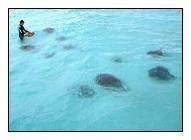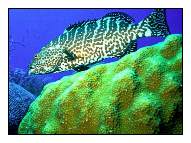Three islands make up this British
colony - Grand Cayman, Cayman Brac, and Little Cayman. Grand Cayman located some 150 miles south of Havana,
Cuba and about 180 miles west of Jamaica is the largest of the three islands (22 miles wide by four miles wide). George Town, on Grand Cayman,
is the capital, serving mostly as a business center that borders a protected harbor popular with cruise ship passengers pouring
in for top-notch duty-free shopping.
 The National Museum occupies one of the few remaining 19th-century buildings, and chronicles the natural and seafaring
history of the Caymans. Resorts and hotels line the cool, white sands of the renowned Seven Mile Beach, which is a
popular spot where many visitors wind down after a morning of excursions. A must-see is Stingray City where you can snorkel
with the inhabitants of Stingray City.
The National Museum occupies one of the few remaining 19th-century buildings, and chronicles the natural and seafaring
history of the Caymans. Resorts and hotels line the cool, white sands of the renowned Seven Mile Beach, which is a
popular spot where many visitors wind down after a morning of excursions. A must-see is Stingray City where you can snorkel
with the inhabitants of Stingray City.
90 miles east north east of Grand Cayman
is Cayman Brac. This island long known to those seeking to get away from it all. The "brac" or bluff crosses the island
and along the shore. See orchids, papaya and mango tress, cactus and agave, as well as a bird population that includes the
rare Cayman Brac parrot.
 On Little Cayman, relax in a small hotel, lodge or a luxury condo. The main attractions here are diving the wall at Bloody
Bay and fishing for tarpon and bonefish.
On Little Cayman, relax in a small hotel, lodge or a luxury condo. The main attractions here are diving the wall at Bloody
Bay and fishing for tarpon and bonefish.
Originally
named Las Tortugas (The Turtles) by Columbus when he sailed past and saw the sea alive with turtles, the Caymans are still
rich with marine life, thanks to a mostly undisturbed environment and strict protection laws. Though suburban life and conveniences
have settled comfortably into the Grand Cayman, you still find the simple life, relaxed life that have always made these islands
so attractive.
An overview of Cayman Islands turtle farm,
one of the main tourist attraction
 An overview of Cayman Turtle Farm's hatchling tanks and
breeding pond before Hurricane Michelle on November 4, 2001 An overview of Cayman Turtle Farm's hatchling tanks and
breeding pond before Hurricane Michelle on November 4, 2001 |
 Information about the turtles is posted at various stations
around the farm to assist visitors during their self-guided tour Information about the turtles is posted at various stations
around the farm to assist visitors during their self-guided tour |
 The farm currently cares for over 16,000 turtles of various
ages and sizes. Now that's a lot of turtles! The farm currently cares for over 16,000 turtles of various
ages and sizes. Now that's a lot of turtles! |
 The larger turtles are kept in the man-made breeding pond.
Some grow as large as 600 lbs! The larger turtles are kept in the man-made breeding pond.
Some grow as large as 600 lbs! |

Feeding time at the farm. The turtles are fed a
special blend of "turtle chow" customized to their dietary needs |
 Green Sea Turtles (Chelonia mydas) mating in Cayman
Turtle Green Sea Turtles (Chelonia mydas) mating in Cayman
Turtle
Farm's breeding pond |
 A female Green Sea turtle crawls around on the
Turtle Farm's man-made beach. She may be searching for a nesting site, although Green Sea turtles usually lay their eggs at
night A female Green Sea turtle crawls around on the
Turtle Farm's man-made beach. She may be searching for a nesting site, although Green Sea turtles usually lay their eggs at
night
|

Close-up of a female Green Sea Turtle as she is digging a nest for her eggs. The tears that she sheds
are to protect her eyes from the sand as she digs
|

A typical nest dug by a Kemps Ridley (Lepidochelelys kempii) turtle. These turtles normally nest during
the day. Most turtles dig about the same shape of nest; the size and depth varies with the size of the turtle's rear flippers
|

Green Sea Turtle eggs being laid in the nest. One to three eggs come out at a time, until anywhere between 40 - 200 +
eggs are laid. The average nest contains around 100 eggs. Note that the eggs are round not oval
|

In Cayman Turtle Farm's hatchery, the collected eggs are
incubated for 60 days in styrofoam containers packed with sand
|

Each container is labeled with the turtle's ID number, the date and the number of eggs that were laid.
The room is carefully temperature controlled
|

Welcome to the world!
|

A Green Sea turtle hatchling emerges from its egg
|

In the wild, a hatchling would be surrounded by its brothers
and sisters. Once they all hatch, they collectively make their way to the top of the nest
|

When a turtle hatchling first emerges, it usually has a yolk sac attached to its belly. This absorbs
into the body within 2-3 days. It is during this time that the hatchlings make their way to the surface of the beach
|

Each nest's hatchlings are kept in moist containers in the hatchery at the Cayman Turtle Farm for
the first 2-4 days. This is to imitate the natural time it takes before they enter the water
|

Once the hatchlings' bellies are closed, they are moved from the hatchery to the hatchling tanks
|

Hatchlings are carefully monitored, fed and cleaned by experienced staff
|

Gee, it's great to be swimming at last!
|

Within only a few months, the hatchlings grow larger than
hand size…
|

As they grow, their colour changes from a black upper
shell to the beautiful browns and yellows most commonly recognized
|
 Here's a lively little one! Here's a lively little one! |

Everyone loves to "hug a turtle"! Turtles around a year old from the 'pick-up' tank can be held for
a unique photo opportunity |
 Two lovely young ladies pose with their newly found friends. Two lovely young ladies pose with their newly found friends. |
 Within 2-3 years, these turtles grow too large to be easily
handled. By age 4, they usually weigh around 50-60 lbs Within 2-3 years, these turtles grow too large to be easily
handled. By age 4, they usually weigh around 50-60 lbs |

An adult turtle seen from underwater
|

Other inhabitants of the Turtle Farm…the Cayman iguana (Cyclura nubilia lewisi) is found only
in Grand Cayman and is an endangered species |

The blue and yellow Macaw (Ara arauna) is a native of Central America on display at the Turtle
Farm. Indigenous green parrots also live at the farm |

After your tour of the farm, the Gift Shop has many wonderful, unique souvenir items to help you remember
your visit. Proceeds from shop sales help towards the care and feeding of all of the turtles on the farm |

The whole family enjoyed the Cayman Turtle Farm adventure! |

Hawksbill turtle (Eretmochelys imbricata) swimming in the waters off Grand Cayman |

Green Sea turtle swimming in the waters off Seven Mile beach, Grand Cayman. And yes, the water really
is that colour! |

